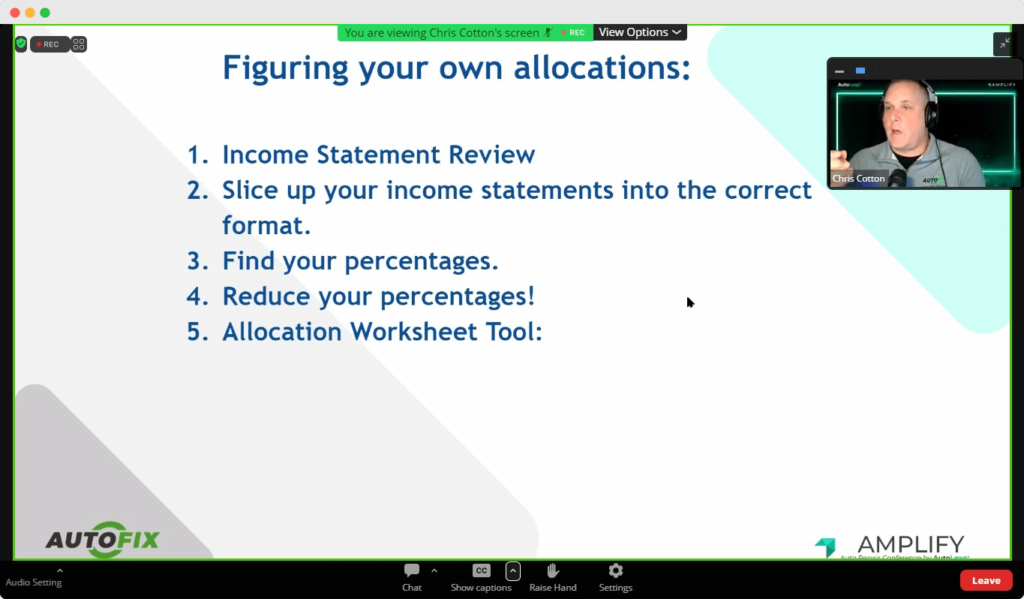Amplify 2023 focused on helping auto shop owners enhance shop management, become more number-driven, and implement the essentials for growth. For this reason, Chris Cotton, owner of AutoFix and host of the podcast Weekly Blitz, joined us to talk about all things profit and cash flow.
We put together a quick summary of the session to make sure you don’t miss out. Let’s get started!
» Want to grow your auto repair business? Click here to schedule a demo.
Summary
Here’s a quick summary of Chris’s talking points from the Amplify 2023 session:
- Why is cash flow management important?
- How should you manage your sales tax
- How to manage all your different expenses
- How to create and adjust allocations
Why is cash flow management important?
There’s never a good time for an emergency to pop up. Sometimes, it strikes when you’re least prepared for it. Shop owners need to be aware of this possibility and always have a contingency plan. That’s where cash flow management comes in.
Cash flow management lets you see what your expenses are, what services are bringing in revenue, and what’s the net profit that you’re making.
These metrics can then help you:
- Plan for emergencies
- Manage your debt
- Attract investors
- Build a strong reputation in the marketplace
- Build a sustainable business
How should you manage your sales tax?

Chris spoke at length about how many businesses end up with a lack of cash reserves and wondering how they’ll ever pay their sales tax.
This should never be a problem! Sales tax should be removed from the source and sent off to a different bank account as soon as you receive it. According to Chris, “Sales tax doesn’t belong to you. It always comes out before you do anything.“
Set up a separate bank account and move the tax into it as soon as a sale is made so your sales tax is never a part of your calculations. Set it away immediately.
Set up separate bank accounts
Chris then talked about the importance of setting up separate bank accounts for a business and allocating funds to each based on your expenses such as income tax, debt, operating expenses, parts, and payroll.
This makes cash management easier by letting you see exactly where you’re at any day.
Set your allocations
The session continued to discuss healthy financial habits. Chris recommended businesses review their income statement to calculate business KPIs.
“Income statement is really one of the places to go for KPIs.”
This will help you spot irregularities such as missing tax payments or decreasing profit margins in a timely fashion.
Then, slice up your statement to see where each of your expenses are at. Take out your highlighters and get to work!
We need the starting point in order to improve our numbers. You’ll have operating expenses, parts, payroll, profit, and tax. Additionally, you might have debt and tire sales to track.
The goal is to reduce your expenses and increase your profit as your business grows.
As per Chris, these are the percentages you should be meeting or aiming for:
- Operating expenses = 20%
- Parts = 20%
- Payroll = 30%
- Profit = 25%
- Tax = 5%
Word of caution: Keep your income statement updated at all times and don’t get more than five to seven days behind. This is key to tracking your expenses and improving your percentages.
Adjusting your allocations

Next, it’s time to adjust your allocations. No business operates at the same expenses every month. Sometimes you’ve got to raise your labor rate, sometimes specific parts become more expensive.
Chris recommends you review your income statement every quarter and adjust your allocations.
Set up quarterly and yearly targets for your shop and evaluate your numbers against these to make sure you’re on track.
Remember, the goal is to be profitable so keep that in mind as you adjust your allocations. Growing businesses keep working on increasing their profit percentage.
Here is the step-by-step process that Chris recommends:
- Direct all incoming sales into your income account
- At the end of every week, send the sales tax into its dedicated account.
- At the end of every month, add your expenses to each of the separate bank accounts.
- At the end of every quarter, pay your business taxes.
- If you’ve got any money left in your income account, check if you need to make a disbursement such as paying back a loan.
- Once you’re debt-free, send the remainder into a profit-hold account to create a back-up for your business.
- At the end of every year, send your financial statement to your accountant and make sure your taxes are all paid.
- If, after this, you’ve got money left in your profit-hold account, discuss with your accountant how to best utilize this.
- You can pay yourself or set it as a back-up or even plan to grow your business.
That’s the quick recap! Now, always make sure that all your bills are paid and your financial statement stays up to date. That’s really the key to making this system work.
Chris suggests that you keep following this method and you’ll eventually get into the rhythm of managing your cash flow well.
» Looking to transform your shop? Discover how AutoLeap can help.
Final thoughts
Maintaining a healthy cash flow is key to a successful auto repair business. Use these tips from Chris Cotton to get into a growth mindset and always be prepared for emergencies.



 Demo
Demo







